Nepal Army needs Indian arms badly
NEPAL-INDIA SECURITY TALKS
NEW DELHI: High level talks between Nepal and India on security challenges and cooperation concluded in Pune, Maharashtra today.
Officials of both countries will formally sign a minute tomorrow. A 15-member Nepali team was led by Hari Kumar Shrestha, South Asia Division Chief of Foreign Ministry, while the Indian team was led by Satish Mehta, Northern Division Chief of Indian Ministry of External Affairs. Six high level army officials of Nepal also participated. Senior Indian army and police officials are among the Indian delegates.
The Nepali team informed about Nepali Army’s need of arms and ammunition, military hardware, vehicles, uniforms, equipment and advanced training for army officers, said Nepali team member colonel Ashok Narsingh Rana, military attaché at the Embassy of Nepal. “As far as resumption of Indian arms assistance to Nepal is concerned, government of Nepal needs to make a formal request to the Indian government,” Rana said. He said though the Indian government was ready to resume arms supply to Nepal, it wanted to do so only when the government of Nepal makes a formal request. Rana said the Indian government understood well the sensitivity of resuming arms supply at this stage when the peace process was still on. Nepali Army is in dire need of arms and ammunition for its training and other duties including for peace missions, but the government of Nepal has so far shied
away from making a formal request to the Indian government for the same due to UCPN-M objection. Rana said details of Indian
assistance on security would be discussed in future at higher levels.
Both the teams dealt with aspects of close cooperation including intelligence sharing so that both armies could sufficiently counter security challenges in their territories, said Rana. Asked if the Indian side raised the issue of Nepal being used by forces inimical to India including the issue of fake Indian currency, Rana said the Indian side did not raise those issues. Seizure of huge amounts of fake Indian currency in Nepal in recent years and reports of anti-India elements exploiting the open Nepal-India border to pump fake Indian currency into the Indian market to destabilise the Indian economy have worried the Indian government.
The modern Nepalese Army was founded in 1762, and today consists of 22 battalions and 44 independent companies. At least one of these is cavalry, and a few others have since WWII converted to artillery, engineers and signals without any change in their old names or in their colours. The Nepalese gave the British Army quite a licking in an 1814-16 border war, and have been perpetual friends and allies of Britain and India ever since. Nepal supplied the British Indian Army with ten regiments of Gurkha mercenaries. At Indian independence six remained in India, and four went directly to the British Army. By British tradition these are "Rifle" regiments and do not carry colours. The Nepalese Army on the other hand has always been sovereign, and shows not a trace of British influence. Nepalese units have been rotating on UN peacekeeping duty in Lebanon since 1978, but I don't know if they have taken their Colours with them.Officials of both countries will formally sign a minute tomorrow. A 15-member Nepali team was led by Hari Kumar Shrestha, South Asia Division Chief of Foreign Ministry, while the Indian team was led by Satish Mehta, Northern Division Chief of Indian Ministry of External Affairs. Six high level army officials of Nepal also participated. Senior Indian army and police officials are among the Indian delegates.
The Nepali team informed about Nepali Army’s need of arms and ammunition, military hardware, vehicles, uniforms, equipment and advanced training for army officers, said Nepali team member colonel Ashok Narsingh Rana, military attaché at the Embassy of Nepal. “As far as resumption of Indian arms assistance to Nepal is concerned, government of Nepal needs to make a formal request to the Indian government,” Rana said. He said though the Indian government was ready to resume arms supply to Nepal, it wanted to do so only when the government of Nepal makes a formal request. Rana said the Indian government understood well the sensitivity of resuming arms supply at this stage when the peace process was still on. Nepali Army is in dire need of arms and ammunition for its training and other duties including for peace missions, but the government of Nepal has so far shied
away from making a formal request to the Indian government for the same due to UCPN-M objection. Rana said details of Indian
assistance on security would be discussed in future at higher levels.
Both the teams dealt with aspects of close cooperation including intelligence sharing so that both armies could sufficiently counter security challenges in their territories, said Rana. Asked if the Indian side raised the issue of Nepal being used by forces inimical to India including the issue of fake Indian currency, Rana said the Indian side did not raise those issues. Seizure of huge amounts of fake Indian currency in Nepal in recent years and reports of anti-India elements exploiting the open Nepal-India border to pump fake Indian currency into the Indian market to destabilise the Indian economy have worried the Indian government.
Todd Mills, 21 June 1997
At the official site of the Royal Nepalese Army, is what would seem to be the Royal Nepalese Army flag: red, about 1:2, with a black swords-wreath-crown-moon device (as seen on the Nepalese flag) in the fly and the Nepalese national flag on a red bordered white rectangle in upper hoist.
Joe McMillan, 28 January 2003
In the device, the wreath is on the bottom, and it is probably a swords/wings*/torch device in the center.
Nathan Lamm, 28 January 2003
*These are not wings, but two crossed "kukris" -- Gurkha knives. A photograph of one can be found here.
Santiago Dotor, 29 January 2003
Police or Army Flag
From Flaggenmittelungen 1795(?), translated by Jarig Bakker:
Nepal: On a postage stamp a police- or army- flag has been depicted: on blue with a red border two crossed golden swords, on top of which a laurel wreath. On top of the center piece the royal crown with tail (?), all in white; below the center piece a white banderole with red inscription (text not readable)Jaume Ollé, 09 Oct 1999
Army Colours
The sample colours are adapted (scanned and considerably retouched) from watercolours in "Royal Nepalese Army Colours: a Short History" by an Army History Task Force (1991). The book gives a brief history of each battalion and company, but virtually no information on the significance of the colours. They seem to follow no rules, and vary wildly in size, shape, and colours. In fact, these variations seem to be the distinctions between units. (Two units have flags in the same shape as the national flag.) Most of the Army units date from the late 18th and early 19th century, and their flags do not appear to have been altered in any way since then. The devices on the national flag occur frequently on Army colours. Other common devices are a dagger, and a pair of footprints.Todd Mills, 21 June 1997
According to Smith (1975b), the footprints of Buddha point to Buddha's birthplace in what is now Nepal.
Ole Andersen, 13 October 1999
All 46 flags and colours of the Royal Nepalese Army can be seen on the RNA website.
Gerald Noeske, 1 July 2005
"Main Colours"
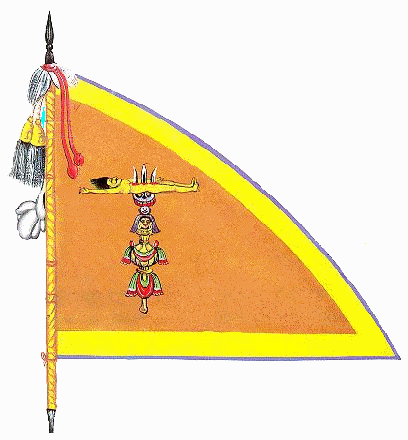 by Todd Mills, 21 June 1997 [Click on flag for larger image.]
by Todd Mills, 21 June 1997 [Click on flag for larger image.]This one is paraded on the right of all the battalions and companies, is believed to pre-date the modern Army (1762), and is considered the main flag of the whole army.
Colours of Shree Devidutta Battalion
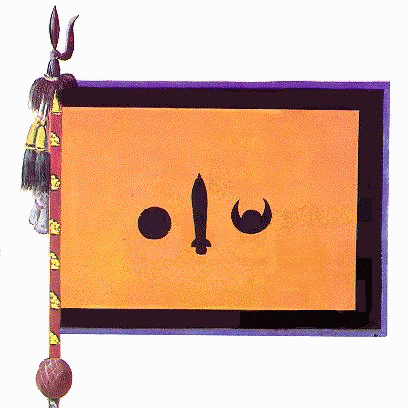 by Todd Mills, 21 June 1997
by Todd Mills, 21 June 1997[Click on flag for larger image.]
Awarded by the King in 1785 for gallantry in battle. These Colours are considered "divinely consecrated" and every officer in the Army takes his oath while touching these Colours. The Colours are also considered the protector of the Capital and never leave Kathmandu.
Colours of Shree Bhairavnath Battalion
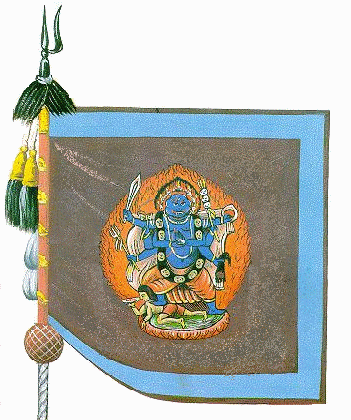 by Todd Mills, 21 June 1997
by Todd Mills, 21 June 1997[Click on flag for larger image.]
Raised in 1810, and now a parachute battalion.
Colours of Shree Ganeshdal Battalion
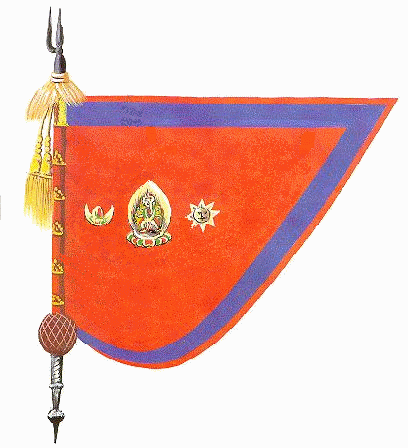 by Todd Mills, 21 June 1997
by Todd Mills, 21 June 1997[Click on flag for larger image.]
Raised in 1846, and now responsible for all the signals and communications of the Army.
Colours of Shree King's Household Cavalry
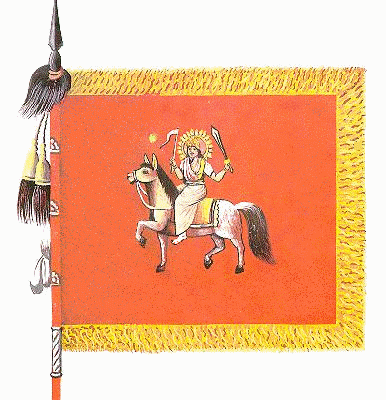 by Todd Mills, 21 June 1997
by Todd Mills, 21 June 1997[Click on flag for larger image.]
Raised in 1849, and has acted as Household Cavalry ceremonial unit since 1952.
Colours of Shree Vajradal Company
 by Todd Mills, 21 June 1997
by Todd Mills, 21 June 1997[Click on flag for larger image.]
Raised 1806.
Colours of Shree Bhagvati Prasad Company
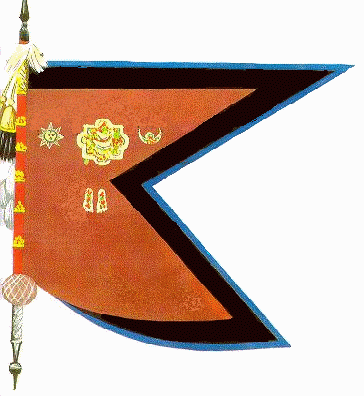 by Todd Mills, 21 June 1997
by Todd Mills, 21 June 1997[Click on flag for larger image.]
Raised in 1927.
Colours of Shree Parshwavarti Company
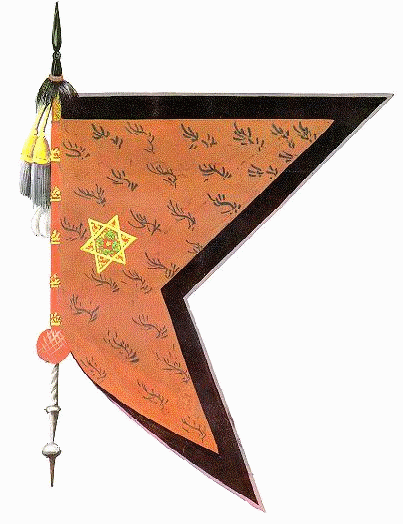 by Todd Mills, 21 June 1997
by Todd Mills, 21 June 1997[Click on flag for larger image.]
Raised 1936 and disbanded 1952. Was the Prime Minister's bodyguard.
Gorkha Soldiers Organization
![[Gorkha
Soldiers Organization]](http://www.crwflags.com/fotw/images/n/np_gsorg.gif) by Roman Kogovsek
by Roman KogovsekGorkhas are professional soldiers, who have been and still are serving in Nepalese and foreign armies (India, Great Britain, Brunei). This organization mainly advocates for their social rights.
Roman Kogovsek, 30 June 2005
Nepal Commander in Chief
Last modified: 2010-12-10 by ian macdonaldKeywords: nepal | commander in chief |
Links: FOTW homepage | search | disclaimer and copyright | write us | mirrors
![[Nepali Commander in Chief, 1969]](http://www.crwflags.com/fotw/images/n/np%5Ecic969.gif)
Army Day 2067 and Maha-shivaratri

EARTHQUAKE RISK REDUCTION AWARENESS PROGRAM
 NDIAN COAS OFFICIAL VISIT
NDIAN COAS OFFICIAL VISIT 
25th Anniversary of Sainik Awasiya Mahavidalaya, Bhaktapur

NA AT RESCUE WORK AFTER THE ACCIDENT OF TARA AIR AT OKHALDHUNGA.

Defense Correspondences' Visit to National Park and Road Construction Areas

RESCUE OF PASSENGERS FROM LUKLA.

COAS VISIT TO UK

NA AT RESCUE WORK AFTER THE ACCIDENT OF AGNI AIR.

NEPALESE ARMY IN DEMINING ACTIVITIES
NEPALESE ARMY AT RESCUE MISSION (SILDUJURE, KASKI)

 Nepal Armed Force Photo Gallery
Nepal Armed Force Photo Gallery
The Nepali Army is the army of Nepal and a major component of the Military of Nepal. Service is voluntary and the minimum age for enrollment is 18 years.
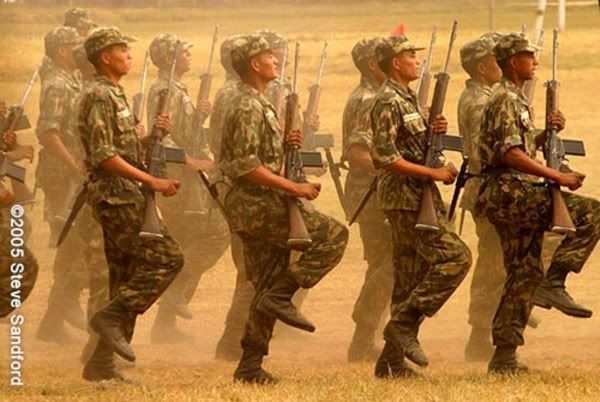
Fresh Nepalese army recruits kick up the dust during an open military drill in Kathmandu recently.

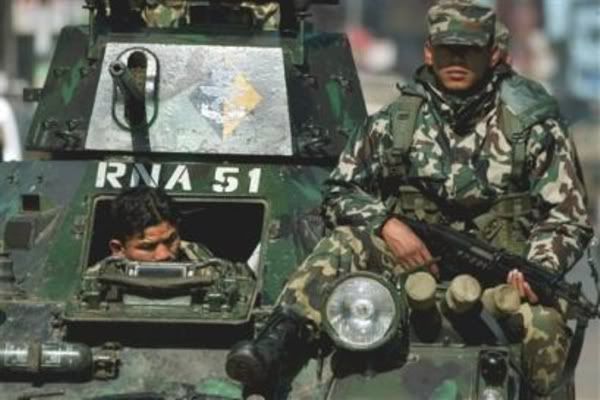
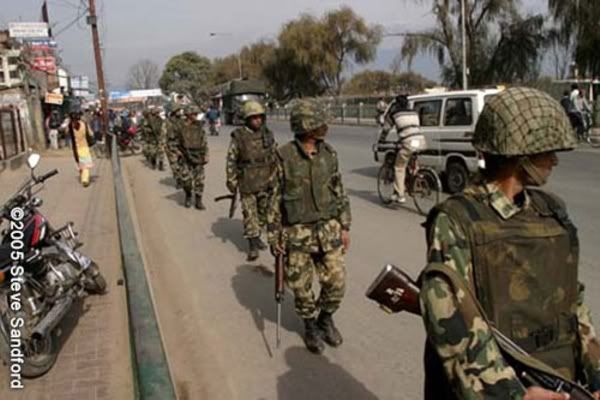
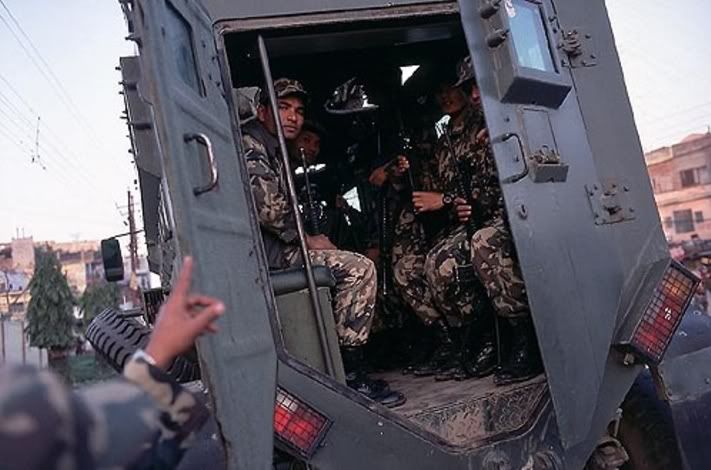
Nepalese soldiers patrol the streets.

A soldier (left) and a member of the armed police stand guard at the Durbar Square in Patan in the evening.
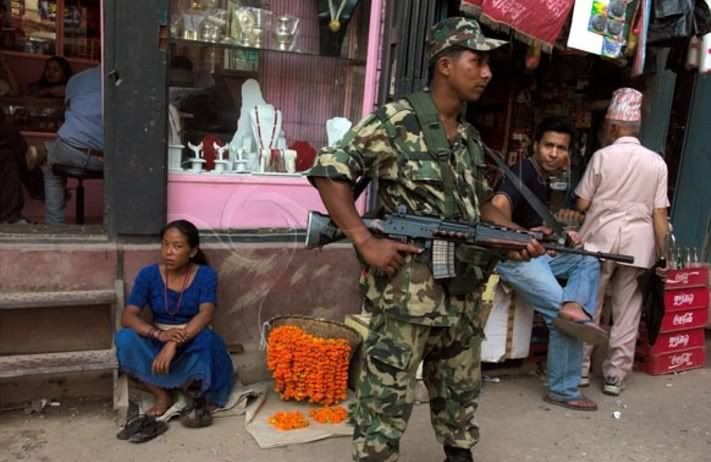
Tight security in the city centre following the declaration of a state of
emergency by the King.






































































































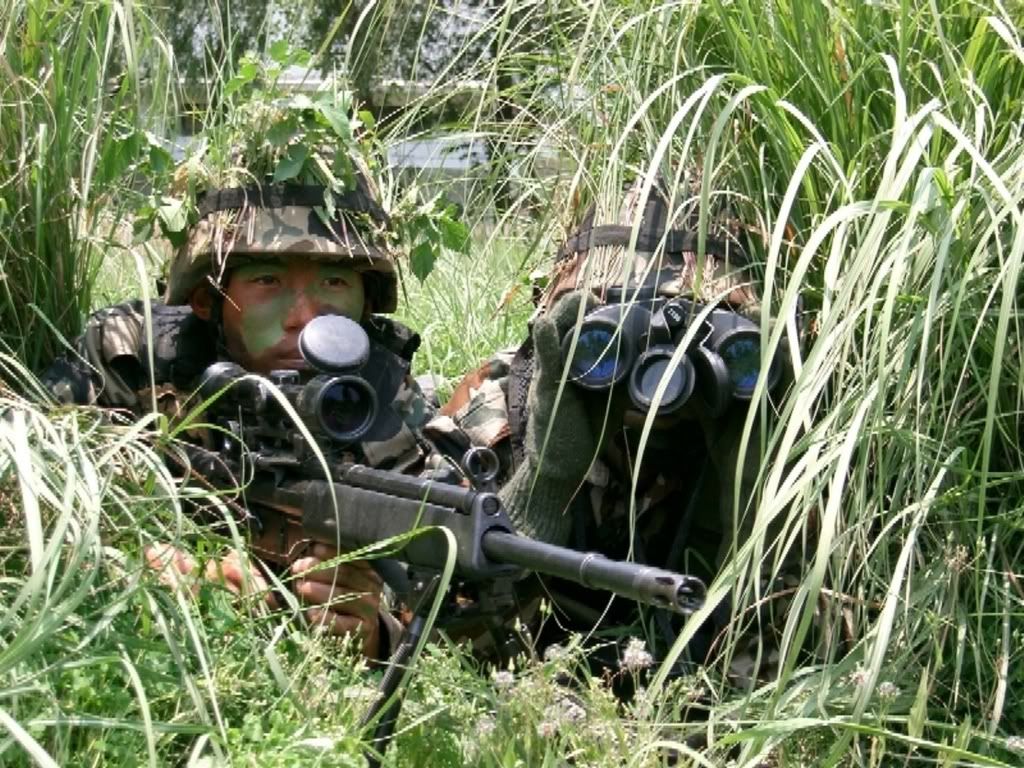
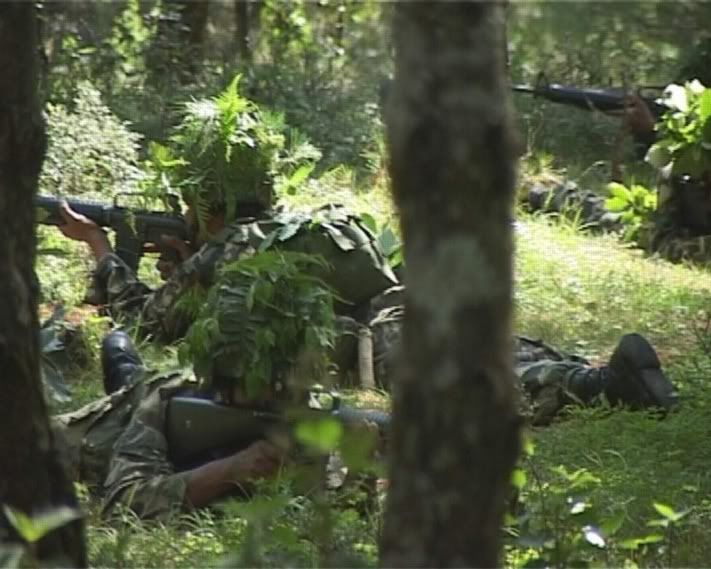
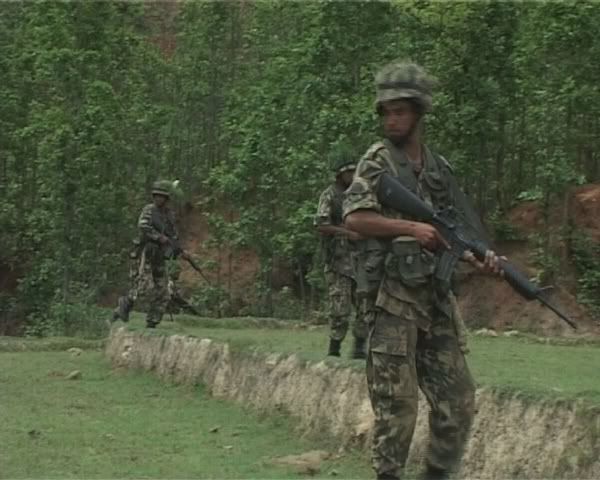

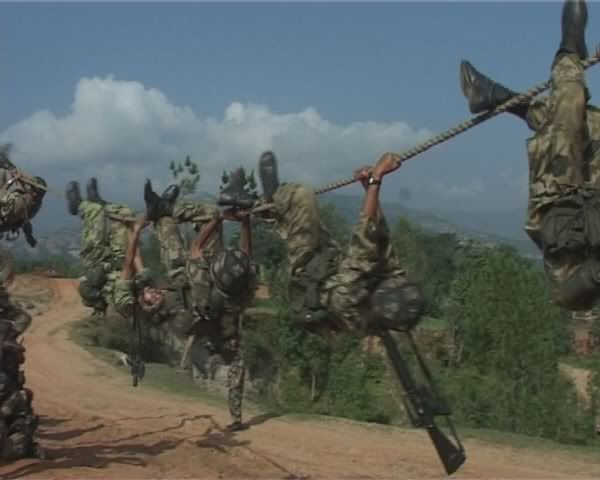
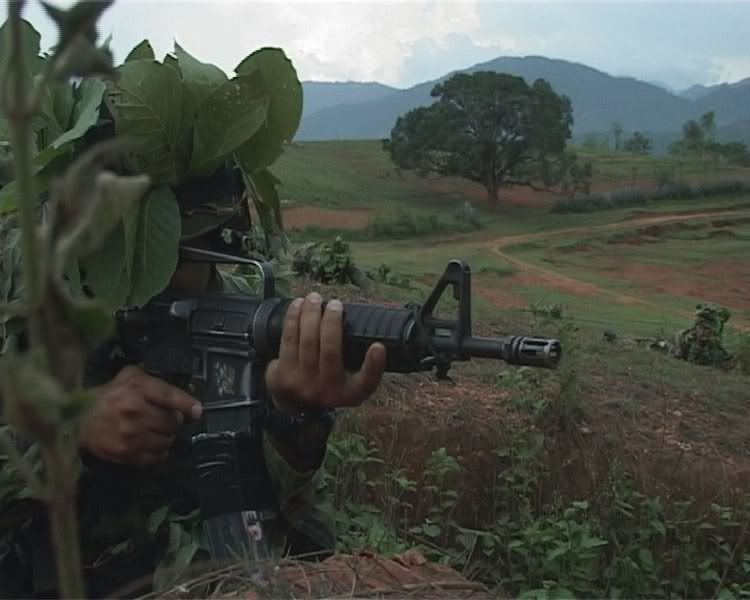
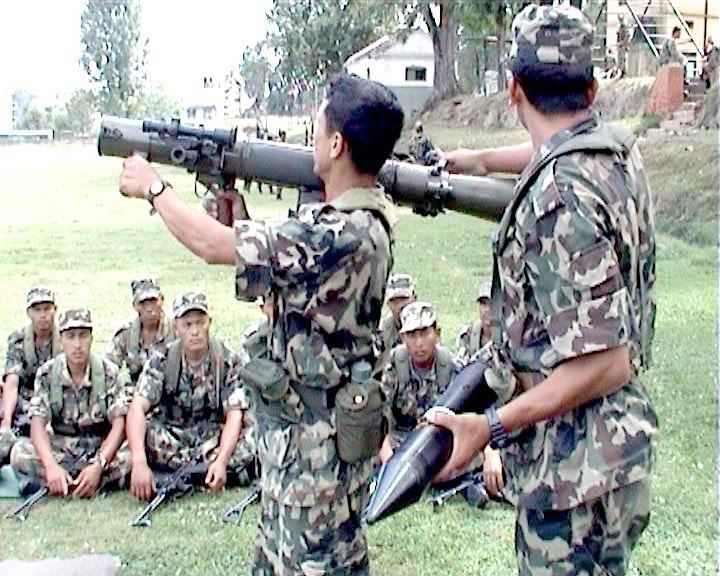

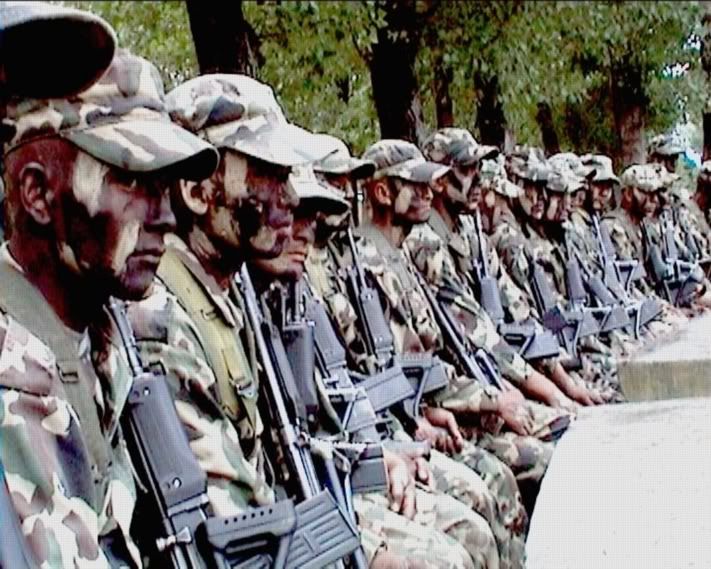
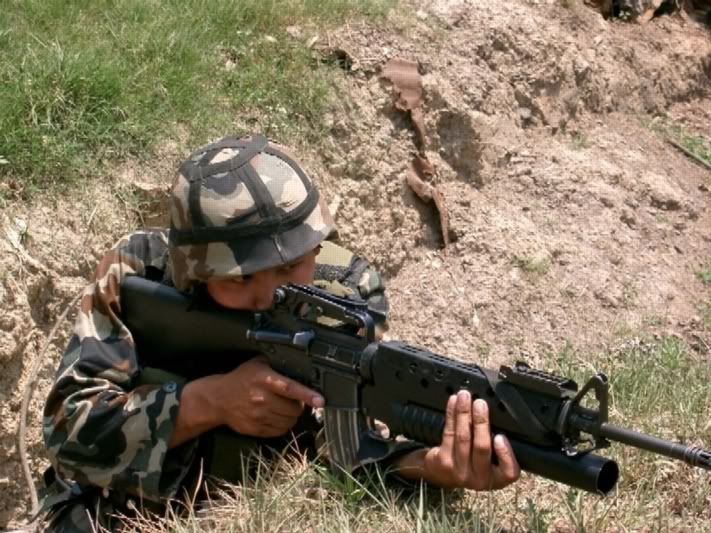



No comments:
Post a Comment